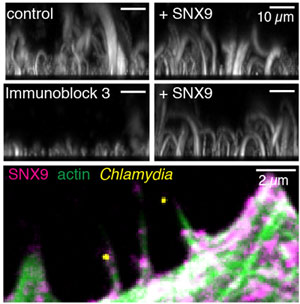Studies of pathogen-host interactions frequently illuminate novel insights into fundamental cell biology. Previously, the Hayward laboratory revealed that like some viruses the human pathogen Chlamydia trachomatis hijacks filopodial capture for entry into target mammalian cells via SNX9, a host factor that links the actin cytoskeleton and membrane dynamics (https://www.path.cam.ac.uk/news-items/20180514).
 Now, a new collaborative paper with Dr Jenny Gallop at the Gurdon Institute and with Astra Zeneca published in the Journal of Cell Biology that combines in vitro reconstitution, antibody technology and infection biology (https://rupress.org/jcb/article/219/4/e201909178/151579/A-direct-role-for-SNX9-in-the-biogenesis-of?searchresult=1) shows that SNX9 is a key mediator of filopodia formation in cells, and that Chlamydia hijacks these endogenous structures to drive its entry, a critical step during the infection process.
Now, a new collaborative paper with Dr Jenny Gallop at the Gurdon Institute and with Astra Zeneca published in the Journal of Cell Biology that combines in vitro reconstitution, antibody technology and infection biology (https://rupress.org/jcb/article/219/4/e201909178/151579/A-direct-role-for-SNX9-in-the-biogenesis-of?searchresult=1) shows that SNX9 is a key mediator of filopodia formation in cells, and that Chlamydia hijacks these endogenous structures to drive its entry, a critical step during the infection process.
More detail of this study and its significance can be found at the Gurdon Institute (https://www.gurdon.cam.ac.uk/news/jarsch-gallop-snx9) and in the accompanying commentary in the Journal of Cell Biology by Lebek and Campellone (https://rupress.org/jcb/article/219/4/e202002086/151588/Adding-SNX-to-the-mix-SNX9-drives-filopodia?searchresult=1).
Work in the Hayward laboratory is funded by the Medical Research Council.

